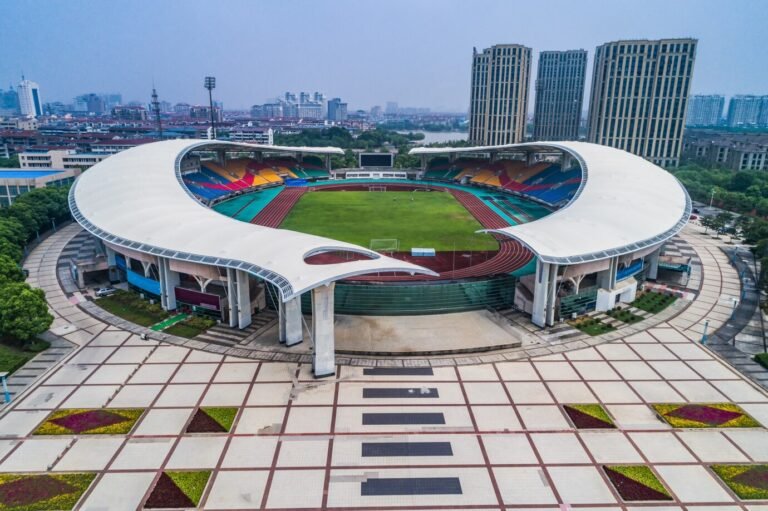
Nestled in the heart of Abu Dhabi, Zayed Sports City Stadium stands as one of the most iconic sporting landmarks in the United Arab Emirates. Since its inauguration in 1980, this architectural marvel has been at the center of the country’s sporting ambitions, reflecting the vision of the UAE’s founding father, Sheikh Zayed bin Sultan Al Nahyan. With a seating capacity exceeding 40,000, it is not only the largest stadium in the UAE but also a symbol of national pride and unity. Over the decades, it has hosted countless major international events, from football tournaments to tennis matches, and even cultural festivals. Zayed Sports City Stadium is more than just a sports venue—it’s a space where history has been made, where communities come together, and where the spirit of the Emirates comes alive.
Historical Significance and Visionary Roots
Zayed Sports City Stadium was one of the earliest projects built with the intention of making the UAE a hub for sports in the region. Commissioned during a time when the country was rapidly developing, the stadium represented Sheikh Zayed’s dedication to not just economic or infrastructural growth, but also to fostering a healthy and active society. At a time when the region lacked major sporting infrastructure, this stadium became a pioneering symbol of what the future of Emirati sports could look like. It was designed not only as a physical structure, but as a gathering place for people of all backgrounds—a place where international events could be held, and where local talent could be nurtured. Its early establishment laid the foundation for what would later become a flourishing sports culture across the country.
Architecture and Design Excellence
The design of Zayed Sports City Stadium is a brilliant blend of practicality and grandeur. Featuring a circular bowl structure, the stadium was built with visibility and audience experience in mind, ensuring that spectators from every seat have a clear view of the field. Its iconic curved roof covers large sections of the seating area, offering protection from the sun while still allowing natural airflow—an important consideration in the region’s desert climate. The materials used reflect both durability and modernity, ensuring the stadium has stood the test of time. Over the years, the structure has undergone renovations to keep up with international standards, incorporating digital screens, VIP lounges, improved lighting systems, and high-tech turf management systems. Despite its upgrades, it has retained the charm and identity that made it a landmark in the first place.
Host of Prestigious International Events
Zayed Sports City Stadium has been a central venue for some of the most significant events in the UAE’s sporting history. Perhaps most notably, it hosted the final match of the 2019 AFC Asian Cup, a prestigious football tournament that brought together nations from across Asia and drew global attention. Additionally, the stadium has welcomed players and fans for FIFA Club World Cup matches, Gulf Cup tournaments, and friendly matches featuring world-renowned football clubs and national teams. But the stadium’s importance goes beyond football—it has also hosted events like the Mubadala World Tennis Championship, cultural celebrations such as the UAE National Day parades, and even large-scale concerts. These events have positioned the stadium as an international hotspot, attracting fans, media, and tourists from around the world.
A Hub for Community and Youth Development
Beyond the spotlight of international events, Zayed Sports City Stadium plays a vital role in the everyday lives of UAE residents. The surrounding complex includes multiple training grounds, a tennis center, a bowling center, and other facilities that are accessible to the public. It regularly hosts youth leagues, school tournaments, and local training sessions aimed at encouraging physical activity and discovering new talent. The UAE government and various sports organizations use the stadium as a base for national development programs in football, athletics, and tennis, helping to cultivate the next generation of Emirati athletes. For many local children and teens, participating in activities at the stadium is a source of inspiration—a place where dreams of becoming professional athletes start to take shape.
Economic and Touristic Impact
As a landmark attraction, Zayed Sports City Stadium also contributes to Abu Dhabi’s tourism and economy. Events hosted here bring in thousands of international visitors who not only attend the games but also explore the surrounding city, dine in local restaurants, stay in hotels, and shop in malls. The stadium is a popular stop for cultural tours, especially during international sporting seasons. In addition to tourism revenue, the stadium has created jobs in event planning, security, maintenance, and hospitality. By functioning as both a world-class sporting venue and a community center, it helps stimulate the local economy in multiple ways.
Looking Ahead: Future of Zayed Sports City Stadium
As Abu Dhabi continues to grow as a global hub for innovation and excellence, the future of Zayed Sports City Stadium looks just as promising. Plans for further expansion, smart technology integration, and more environmentally sustainable operations are in the pipeline. With the UAE bidding to host more global events—including potential Olympic bids and further FIFA collaborations—the stadium will continue to be at the center of these ambitions. It stands as a testament to how thoughtful investment in sports infrastructure can create lasting social, cultural, and economic benefits for generations to come.